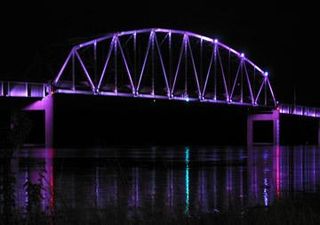Mark Morris Memorial Bridge | |
|---|---|
 | |
| Coordinates | 41°51′53″N90°10′23″W / 41.86472°N 90.17306°W Coordinates: 41°51′53″N90°10′23″W / 41.86472°N 90.17306°W |
| Carries | 2 lanes of |
| Crosses | Mississippi River |
| Locale | Clinton, Iowa and Fulton, Illinois |
| Official name | Mark Morris Memorial Bridge |
| Other name(s) | North Bridge Lyons-Fulton Bridge [1] |
| Maintained by | Iowa Department of Transportation |
| Characteristics | |
| Design | Truss bridge |
| Longest span | 499 feet (152 m) |
| History | |
| Opened | January 1975 |
| Statistics | |
| Daily traffic | 9,800 [2] |
The Mark Morris Memorial Bridge (locally called the North Bridge) is a 2 lane truss bridge across the Mississippi River in the United States. It connects the cities of Clinton, Iowa and Fulton, Illinois. The bridge may also be known as the Lyons-Fulton Bridge, which was the name of a predecessor bridge [1] and the name listed on the USGS topographical map. [3] The town of Lyons, Iowa, was annexed to Clinton in 1895, but the north end of the city is still referred to as Lyons. The bridge is the terminus of both Iowa Highway 136 and Illinois Route 136. The 1975 bridge was named in memory Mark Morris, a long time member of the City of Clinton Bridge Commission who died in 1972. [4] Morris was instrumental in the construction of the 1975 bridge and the City of Clinton Bridge Commission named it in his honor. [5]

A truss bridge is a bridge whose load-bearing superstructure is composed of a truss, a structure of connected elements usually forming triangular units. The connected elements may be stressed from tension, compression, or sometimes both in response to dynamic loads. Truss bridges are one of the oldest types of modern bridges. The basic types of truss bridges shown in this article have simple designs which could be easily analyzed by 19th and early 20th-century engineers. A truss bridge is economical to construct because it uses materials efficiently.

The Mississippi River is the second-longest river and chief river of the second-largest drainage system on the North American continent, second only to the Hudson Bay drainage system. Its source is Lake Itasca in northern Minnesota and it flows generally south for 2,320 miles (3,730 km) to the Mississippi River Delta in the Gulf of Mexico. With its many tributaries, the Mississippi's watershed drains all or parts of 32 U.S. states and two Canadian provinces between the Rocky and Appalachian mountains. The main stem is entirely within the United States; the total drainage basin is 1,151,000 sq mi (2,980,000 km2), of which only about one percent is in Canada. The Mississippi ranks as the fourth-longest and fifteenth-largest river by discharge in the world. The river either borders or passes through the states of Minnesota, Wisconsin, Iowa, Illinois, Missouri, Kentucky, Tennessee, Arkansas, Mississippi, and Louisiana.

The United States of America (USA), commonly known as the United States or America, is a country comprising 50 states, a federal district, five major self-governing territories, and various possessions. At 3.8 million square miles, the United States is the world's third or fourth largest country by total area and is slightly smaller than the entire continent of Europe's 3.9 million square miles. With a population of over 327 million people, the U.S. is the third most populous country. The capital is Washington, D.C., and the most populous city is New York City. Most of the country is located contiguously in North America between Canada and Mexico.
Contents


The bridge was opened in January 1975, replacing an older span upstream that once carried the Lincoln Highway, U.S. Route 30.) [6] In 1982, Iowa DOT announced that it would be removing a 20 cent toll from the Gateway Bridge and the Mark Morris bridge beginning January 1983. Iowa and Illinois agreed to split responsibility for the maintenance of the two bridges with Iowa maintaining the Mark Morris bridge and Illinois the Gateway bridge. [7]

The Lincoln Highway was one of the earliest transcontinental highways for automobiles across the United States of America. Conceived in 1912 by Indiana entrepreneur Carl G. Fisher, and formally dedicated October 31, 1913, the Lincoln Highway ran coast-to-coast from Times Square in New York City west to Lincoln Park in San Francisco, originally through 13 states: New York, New Jersey, Pennsylvania, Ohio, Indiana, Illinois, Iowa, Nebraska, Colorado, Wyoming, Utah, Nevada, and California. In 1915, the "Colorado Loop" was removed, and in 1928, a realignment relocated the Lincoln Highway through the northern tip of West Virginia. Thus, there are a total of 14 states, 128 counties, and more than 700 cities, towns and villages through which the highway passed at some time in its history.

U.S. Route 30 or U.S. Highway 30 is an east–west main route in the system of the United States Numbered Highways, with the highway traveling across the northern tier of the country. With a length of 3,073 miles (4,946 km), it is the third longest U.S. highway, after U.S. Route 20 and U.S. Route 6. The western end of the highway is at US 101 in Astoria, Oregon; the eastern end is at Virginia Avenue, Absecon Boulevard, and Adriatic Avenue in Atlantic City, New Jersey. Despite long stretches of parallel and concurrent Interstate Highways, it has not been decommissioned unlike other long haul routes such as U.S. Route 66.









